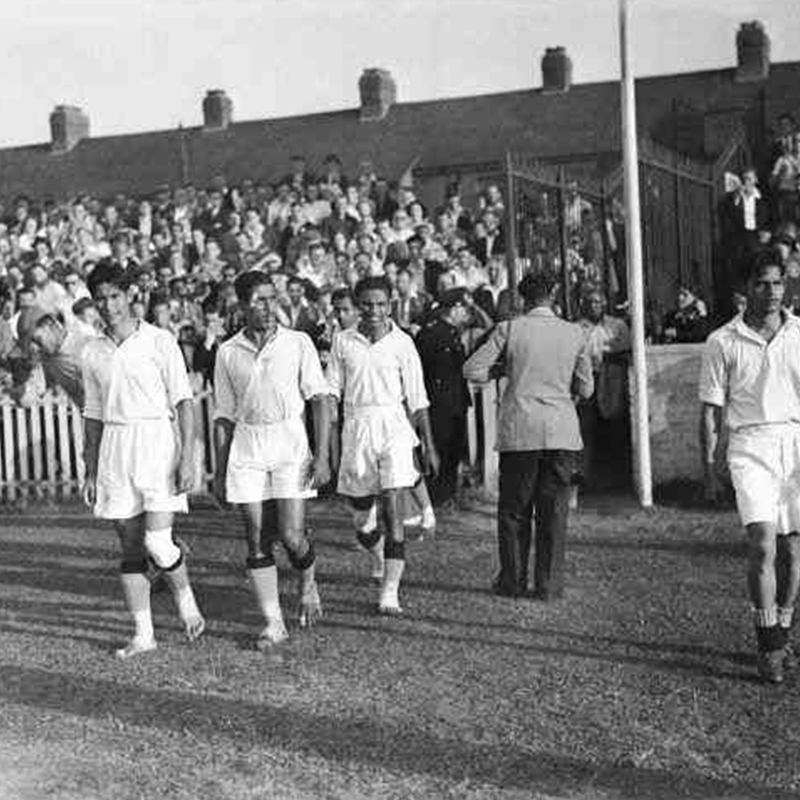In the history of modern football, unusual decisions and major controversies aren’t unheard of.
Harald Schumacher’s infamous collision with Patrick Battiston in the 1982 World Cup semi-final between France and Germany is a notable example. The collision left Frenchman Battiston unconscious for several days. However, the referee refused to award a red card or a free-kick. Now fast forward to the 2002 World Cup campaign which was mired in controversy from the beginning. The questionable refereeing decisions in favour of the host country was criticised worldwide.
However, the most bizarre tale would be that of India’s refusal to play in the 1950 World Cup. The decision is one of the most debated moments in Indian sports history. It is now regarded as the turning point in India’s football in the years that followed.
The 1940s and 1950s
The most difficult era in human history and perhaps the least favourable time for any sport. In the 40s and 50s, the world was witnessing large scale post-war reconstruction. The war tormented the economy and lives of millions of people. Not only did it impact sports, but it also witnessed the gradual decline of football tournaments across the globe. The planned 1942 and 1946 World Cups were cancelled. So, with the onset of the roaring 50s, it was apparent that people were once again interested and football would once again become a talking point. The World Cup in Brazil would be closely followed by the footballing community with FIFA eager to bring in representation from all across the world. However, many countries dropped out early on. Initially, there were 16 teams for the 1950 World Cup when the groups were drawn. However, the number was cut short to 14 after France dropped out, followed by India soon after. Even though France’s refusal was primarily due to economic and travel concerns, India’s decisions were more bizarre and confusing than what was initially reported.
A Chance Botched
In 1950, India managed to qualify for the FIFA World Cup and were drawn with Sweden, Italy, and Paraguay in the group stage. After a successful campaign in the 1948 Olympics, India were already acknowledged by many as the best team from Asia to be heading to Brazil. Most notably, India’s barefoot football was gaining popularity after their incredible performance in the 1948 Summer Olympics hosted in London. A narrow 2-1 loss against France in the Olympics, was in fact a strong performance, which showcased the quality the team had. It was also their first international tournament since independence under the banner of India. With reasonable performances elsewhere in Asia, India were maturing into a footballing nation. With hockey still missing from the games, the country heavily backed the football team to win gold in the Olympic and Asian Games.
With great talents at their disposal and a major tactician in S.A. Rahim in the dugout, India’s football was far more promising than many other teams during the time. Apart from Sweden, teams from Italy and Paraguay weren’t as good as they used to be. Italy fielded a depleted side after losing 8 of their senior players in a plane crash in 1949. So considering the conditions, India had a golden chance at their disposal if they had participated in the World Cup. However, it didn’t happen.
After 1948, FIFA addressed the need for teams to wear boots to play in the World Cup. However, this wasn’t taken as a serious concern during the time. But things changed drastically over time. With Myanmar, the Philippines and Indonesia all withdrawing from the Asian Pool, India was automatically selected for the 1950 World Cup without even kicking a ball once. As the sole representative from Asia, the organising body from Brazil were also keen on India’s participation. Thereby, they were willing to even offer to cover the travel expenses associated with it. But citing several reasons, India refused.
In fact, the journey itself was a growing concern among many countries during this time. So the idea that India’s refusal to play due to financial constraints is largely a secondary concern. The same could also be said about India’s disinterest in playing with Boots. Indian clubs in particular had the provision to play with boots and had players who played with boots. So it was not something that really prevented India from withdrawing. When examined closer, most of these popular theories stem from the very thought of India’s economic situation at the time and not on reality.
However, much later, journalists have uncovered various reasons behind the unusual decision made at the time. As it states, India’s refusal was largely due to the country’s lack of knowledge in the importance of playing in the World Cup. The All India Football Association, the pioneer body behind the country’s football was more concerned with the 1951 Asian Cup. In fact the AIFF was more prepared to face the Asian Games of 1951 than the WC which they found less convincing. It is also worthwhile to say that the Olympics at the time was more prestigious than the World Cup. Therefore it was apparent that India’s refusal was largely associated with this very thought. To the AIFF there was also a major risk to be even considered playing against professional sides with an amateur team. This psychological factor played a key role in decision making and the eventual judgement.
7o years later as we move closer to another World Cup, it is quite interesting to look back at things that should have changed the course of football in India. In fact, the country learned from its mistake and are on the right path. With youth development to modern infrastructure and facilities, India is now well set to qualify for the World Cup in the future.


